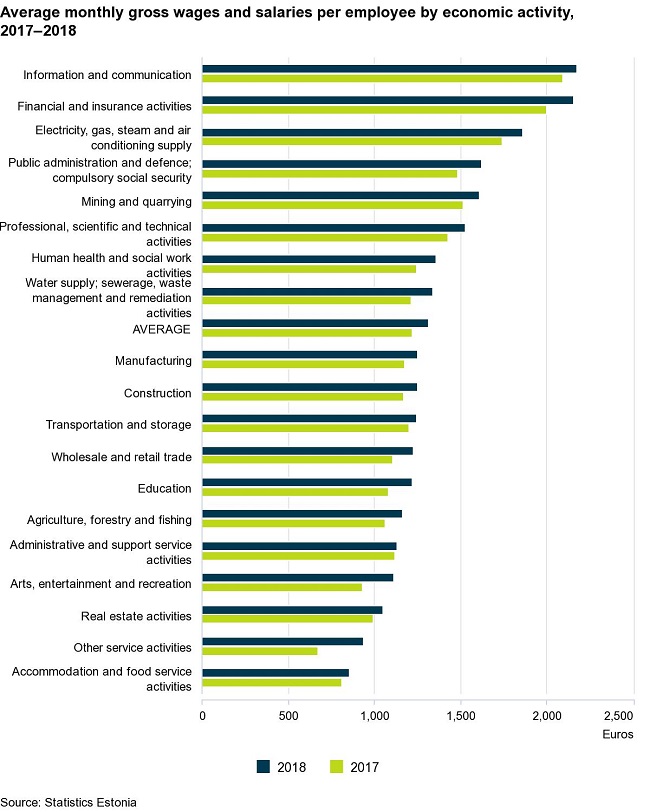Analytics, Estonia, Statistics, Wages
International Internet Magazine. Baltic States news & analytics
Wednesday, 24.04.2024, 00:59
In 2018, the average monthly gross wages and salaries in Estonia were 1,310 euros
 Print version
Print versionIn 2017, the annual increase in the average monthly gross wages and salaries was 6.5%, while in 2018, the growth increased slightly, being at the same level as in 2016. In 2018, the annual increase in the average monthly gross wages and salaries was the slowest in the 2nd quarter (6.4%), accelerating near the year-end.
Real wages, which take into account the influence of the change in the consumer price index, increased slower in comparison with 2017 than the monthly gross wages and salaries, which was due to growing consumer prices. Compared to 2017, real wages rose by 3.7%. In 2018, real wages increased 0.7 percentage point faster than in the previous year.
In 2018, compared to the previous year, irregular bonuses and premiums increased 25% per employee. The average monthly gross wages and salaries excluding irregular bonuses and premiums increased 6.5%. Irregular bonuses and premiums affected the year-over-year increase in average monthly gross wages and salaries by 0.8 percentage points.
In 2018, the average monthly gross wages and salaries continued to be the highest in information and communication (2,172 euros) and in financial and insurance activities (2,154 euros), and the lowest in accommodation and food service activities and other service activities.
Compared to 2017, the average monthly gross wages and salaries increased the most in other service activities (incl. activities of organisations, repair of personal and household goods, services) and in arts, entertainment and recreation. The year-on-year growth in these economic activities is due to a change in Statistics Estonia’s wage statistics methodology, according to which since 2018 also non-profit organisations with less than 50 employees are included.
Additionally, the wages and salaries increased in education (13.1%), wholesale and retail trade (10.8%), water supply; sewerage, waste management and remediation activities (10.2%). The annual average monthly gross wages and salaries increased in all economic activities. The increase was the slowest in administrative and support service activities (1.2%).
In the public sector, including state and municipal institutions and enterprises, the average monthly gross wages and salaries amounted to 1,393 euros (year-over-year growth 10,1%), and in the private sector, including enterprises owned by Estonian and foreign private entities, to 1,283 euros (year-over-year growth 6.4%).
In 2018, by county, the average monthly gross wages and salaries continued to be the highest in Harju (1,455 euros) and Tartu (1,289 euros) counties and the lowest in Hiiu (944 euros) and Saare (987 euros) counties. The average monthly gross wages and salaries increased in all counties. The year-over-year growth in monthly gross wages and salaries was the fastest in Saare, Jõgeva and Rapla counties and the slowest in Võru county.
According to the Wages and Salaries Statistics Survey, in 2018, compared to the previous year, the number of employees converted to full-time units increased 5%. The number of employees in full-time units increased the most in other service activities, arts, entertainment and recreation activities and in real estate activities. The change in these three economic activities is largely due to the inclusion of non-profit organisations with less than 50 employees in the wages and salaries survey.
In 2018, the average monthly labour costs per employee were 1,756 euros and the hourly labour costs 11.61euros. Compared to 2017, the average monthly labour costs per employee increased 6.6%.
4th quarter of 2018
In the 4th quarter of 2018, the average monthly gross wages and salaries were 1,384 euros, having increased 7.2% compared to the previous quarter and 8.9% compared to the 4th quarter of 2017. The average monthly gross wages and salaries were 1,327 euros in October, 1,369 euros in November and 1,455 euros in December. In the 4th quarter of 2018, the average hourly gross wages and salaries were 7.85 euros, having increased 4.5% compared to the 3rd quarter of 2018.
In the 4th quarter of 2018, compared to the 3th quarter of 2018, the average monthly gross wages and salaries increased the most in education (19.8%), arts, entertainment and recreation (14.9%) and in public administration and defence (14.4%). Compared with the previous quarter, the increase in the average gross monthly wages and salaries was the slowest in transportation and storage (1.2%), professional, scientific and technical activities (1.8%).
In the 4th quarter of 2018, compared to the 4th quarter of 2017, irregular bonuses and premiums increased 33% per employee. Irregular bonuses and premiums affected the year-over-year increase in average monthly gross wages and salaries of the 4th quarter by 1.3 percentage points. Without irregular bonuses and premiums, the average monthly gross wages and salaries increased 7.6% compared to the 4th quarter of 2017.
Real wages increased 5% in the 4th quarter of 2018.
| Year | Average monthly gross wages and salaries, euros | Change on the same period of previous year, % |
|---|---|---|
| 2012 | 887 | 5.7 |
| 2013 | 949 | 7 |
| 2014 | 1005 | 5.9 |
| 2015 | 1065 | 6 |
| 2016 | 1146 | 7.6 |
| 2017 | 1221 | 6,5 |
| 2018 | 1310 | 7.3 |









 «The Baltic Course» Is Sold and Stays in Business!
«The Baltic Course» Is Sold and Stays in Business!

